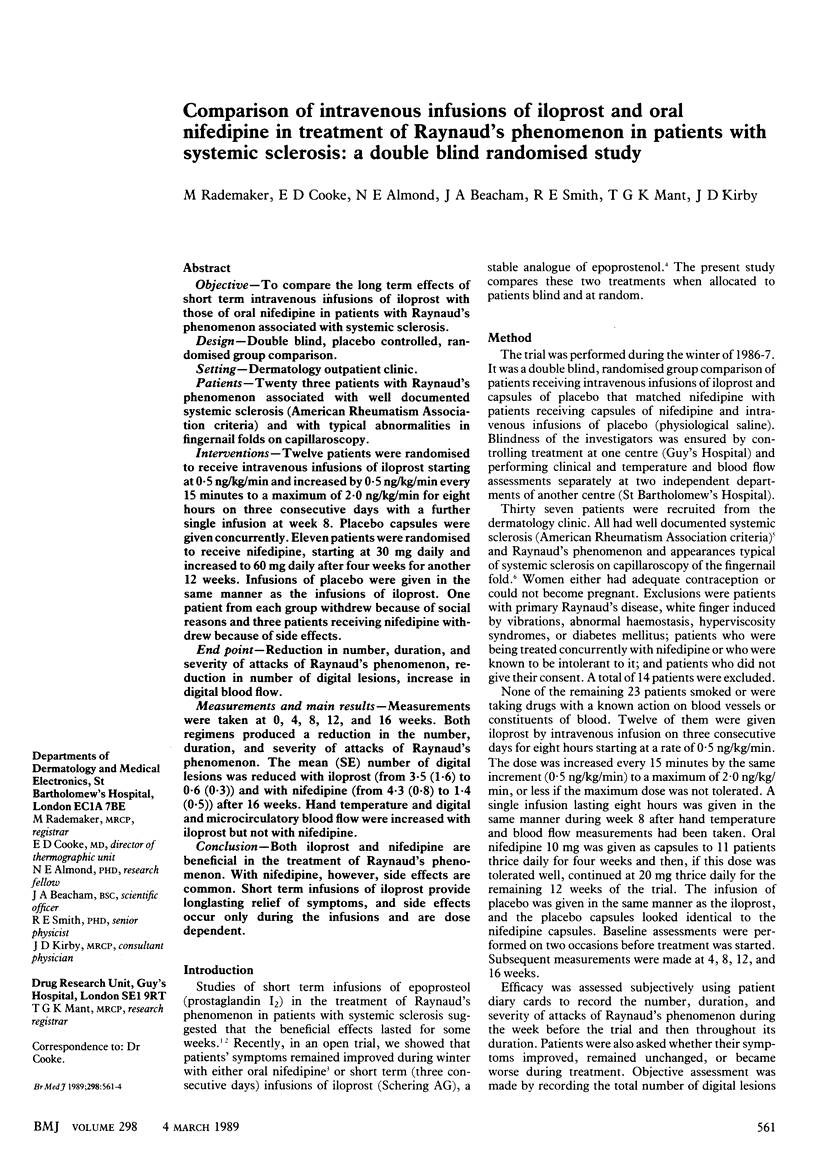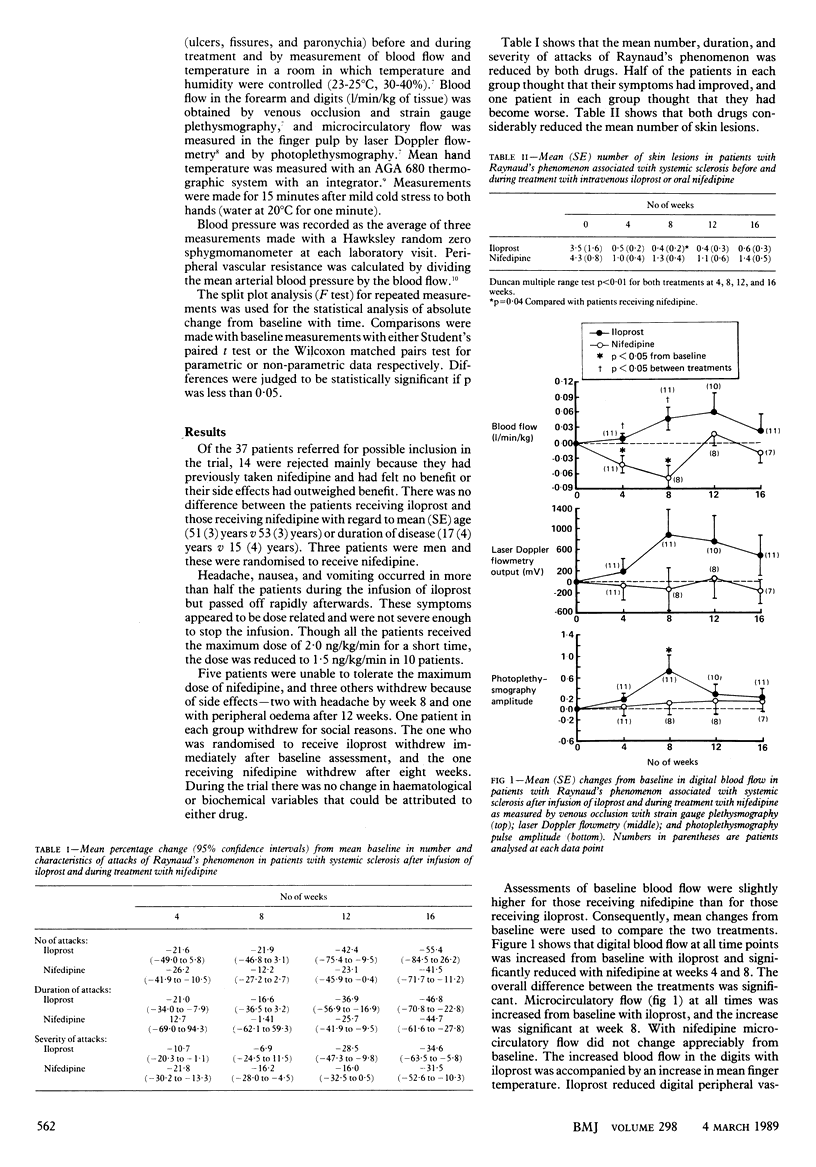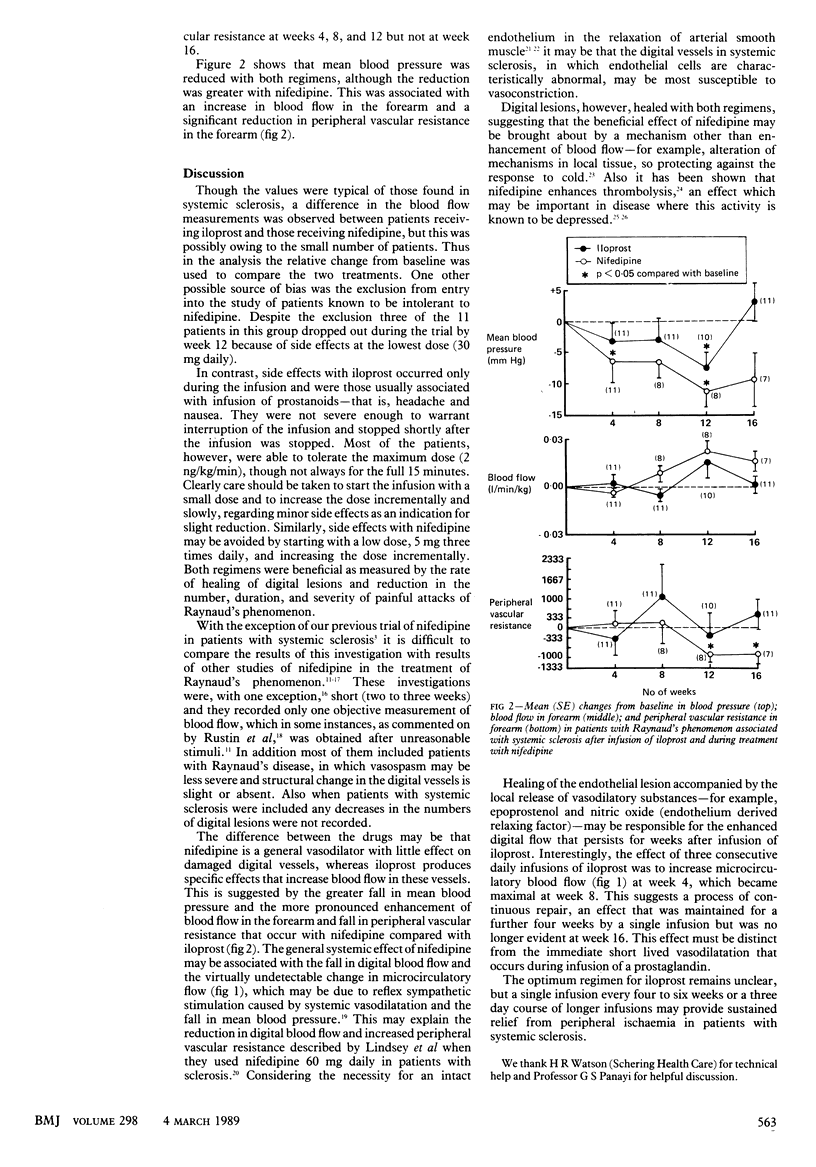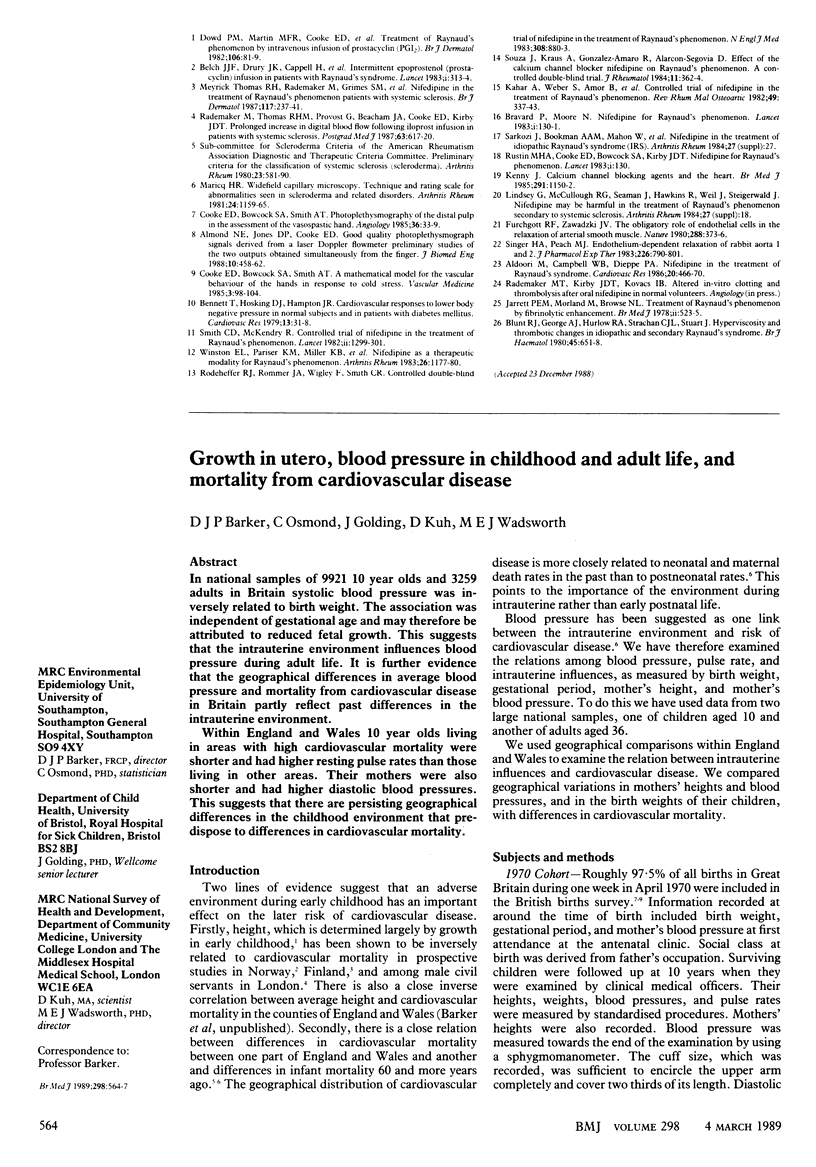Abstract
OBJECTIVE--To compare the long term effects of short term intravenous infusions of iloprost with those of oral nifedipine in patients with Raynaud's phenomenon associated with systemic sclerosis. DESIGN--Double blind, placebo controlled, randomised group comparison. SETTING--Dermatology outpatient clinic. PATIENTS--Twenty three patients with Raynaud's phenomenon associated with well documented systemic sclerosis (American Rheumatism Association criteria) and with typical abnormalities in fingernail folds on capillaroscopy. INTERVENTIONS--Twelve patients were randomised to receive intravenous infusions of iloprost starting at 0.5 ng/kg/min and increased by 0.5 ng/kg/min every 15 minutes to a maximum of 2.0 ng/kg/min for eight hours on three consecutive days with a further single infusion at week 8. Placebo capsules were given concurrently. Eleven patients were randomised to receive nifedipine, starting at 30 mg daily and increased to 60 mg daily after four weeks for another 12 weeks. Infusions of placebo were given in the same manner as the infusions of iloprost. One patient from each group withdrew because of social reasons and three patients receiving nifedipine withdrew because of side effects. END POINT--Reduction in number, duration, and severity of attacks of Raynaud's phenomenon, reduction in number of digital lesions, increase in digital blood flow. MEASUREMENTS AND MAIN RESULTS--Measurements were taken at 0, 4, 8, 12, and 16 weeks. Both regimens produced a reduction in the number, duration, and severity of attacks of Raynaud's phenomenon. The mean (SE) number of digital lesions was reduced with iloprost (from 3.5 (1.6) to 0.6 (0.3] and with nifedipine (from 4.3 (0.8) to 1.4 (0.5] after 16 weeks. Hand temperature and digital and microcirculatory blood flow were increased with iloprost but not with nifedipine. CONCLUSION--Both iloprost and nifedipine are beneficial in the treatment of Raynaud's phenomenon. With nifedipine, however, side effects are common. Short term infusions of iloprost provide longlasting relief of symptoms, and side effects occur only during the infusions and are dose dependent.
Full text
PDF



Selected References
These references are in PubMed. This may not be the complete list of references from this article.
- Aldoori M., Campbell W. B., Dieppe P. A. Nifedipine in the treatment of Raynaud's syndrome. Cardiovasc Res. 1986 Jun;20(6):466–470. doi: 10.1093/cvr/20.6.466. [DOI] [PubMed] [Google Scholar]
- Almond N. E., Jones D. P., Cooke E. D. High quality photoplethysmograph signals from a laser Doppler flowmeter: preliminary studies of two simultaneous outputs from the finger. J Biomed Eng. 1988 Oct;10(5):458–462. doi: 10.1016/0141-5425(88)90152-5. [DOI] [PubMed] [Google Scholar]
- Belch J. J., Newman P., Drury J. K., McKenzie F., Capell H., Leiberman P., Forbes C. D., Prentice C. R. Intermittent epoprostenol (prostacyclin) infusion in patients with Raynaud's syndrome. A double-blind controlled trial. Lancet. 1983 Feb 12;1(8320):313–315. doi: 10.1016/s0140-6736(83)91624-0. [DOI] [PubMed] [Google Scholar]
- Bennett T., Hosking D. J., Hampton J. R. Cardiovascular responses to lower body negative pressure in normal subjects and in patients with diabetes mellitus. Cardiovasc Res. 1979 Jan;13(1):31–38. doi: 10.1093/cvr/13.1.31. [DOI] [PubMed] [Google Scholar]
- Blunt R. J., George A. J., Hurlow R. A., Strachan C. J., Stuart J. Hyperviscosity and thrombotic changes in idiopathic and secondary Raynaud's syndrome. Br J Haematol. 1980 Aug;45(4):651–658. doi: 10.1111/j.1365-2141.1980.tb07188.x. [DOI] [PubMed] [Google Scholar]
- Furchgott R. F., Zawadzki J. V. The obligatory role of endothelial cells in the relaxation of arterial smooth muscle by acetylcholine. Nature. 1980 Nov 27;288(5789):373–376. doi: 10.1038/288373a0. [DOI] [PubMed] [Google Scholar]
- Holgate S. T., Howarth P. H. What's new about hay fever? Br Med J (Clin Res Ed) 1985 Jul 6;291(6487):1–2. doi: 10.1136/bmj.291.6487.1. [DOI] [PMC free article] [PubMed] [Google Scholar]
- Jarrett P. E., Morland M., Browse N. L. Treatment of Raynaud's phenomenon by fibrinolytic enhancement. Br Med J. 1978 Aug 19;2(6136):523–525. doi: 10.1136/bmj.2.6136.523. [DOI] [PMC free article] [PubMed] [Google Scholar]
- Kahan A., Weber S., Amor B., Saporta L., Hodara M., Degeorges M. Etude controlée de la nifédipine dans le traitement du phénomène de Raynaud. Rev Rhum Mal Osteoartic. 1982 Apr;49(5):337–343. [PubMed] [Google Scholar]
- Meyrick Thomas R. H., Rademaker M., Grimes S. M., MacKay A., Kovacs I. B., Cook E. D., Bowcock S. M., Kirby J. D. Nifedipine in the treatment of Raynaud's phenomenon in patients with systemic sclerosis. Br J Dermatol. 1987 Aug;117(2):237–241. doi: 10.1111/j.1365-2133.1987.tb04122.x. [DOI] [PubMed] [Google Scholar]
- Nifedipine for Raynaud's phenomenon. Lancet. 1983 Jan 15;1(8316):130–130. [PubMed] [Google Scholar]
- Nifedipine for Raynaud's phenomenon. Lancet. 1983 Jan 15;1(8316):130–130. [PubMed] [Google Scholar]
- Rademaker M., Thomas R. H., Provost G., Beacham J. A., Cooke E. D., Kirby J. D. Prolonged increase in digital blood flow following iloprost infusion in patients with systemic sclerosis. Postgrad Med J. 1987 Aug;63(742):617–620. doi: 10.1136/pgmj.63.742.617. [DOI] [PMC free article] [PubMed] [Google Scholar]
- Rodeheffer R. J., Rommer J. A., Wigley F., Smith C. R. Controlled double-blind trial of nifedipine in the treatment of Raynaud's phenomenon. N Engl J Med. 1983 Apr 14;308(15):880–883. doi: 10.1056/NEJM198304143081507. [DOI] [PubMed] [Google Scholar]
- Sauza J., Kraus A., González-Amaro R., Alarcón-Segovia D. Effect of the calcium channel blocker nifedipine on Raynaud's phenomenon. A controlled double blind trial. J Rheumatol. 1984 Jun;11(3):362–364. [PubMed] [Google Scholar]
- Singer H. A., Peach M. J. Endothelium-dependent relaxation of rabbit aorta. I. Relaxation stimulated by arachidonic acid. J Pharmacol Exp Ther. 1983 Sep;226(3):790–795. [PubMed] [Google Scholar]
- Smith C. D., McKendry R. J. Controlled trial of nifedipine in the treatment of Raynaud's phenomenon. Lancet. 1982 Dec 11;2(8311):1299–1301. doi: 10.1016/s0140-6736(82)91508-2. [DOI] [PubMed] [Google Scholar]
- Winston E. L., Pariser K. M., Miller K. B., Salem D. N., Creager M. A. Nifedipine as a therapeutic modality for Raynaud's phenomenon. Arthritis Rheum. 1983 Oct;26(10):1177–1180. doi: 10.1002/art.1780261001. [DOI] [PubMed] [Google Scholar]


